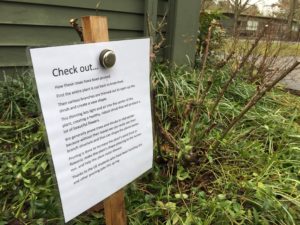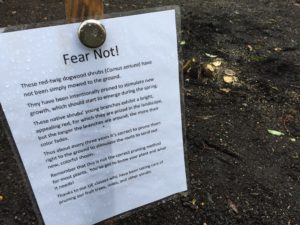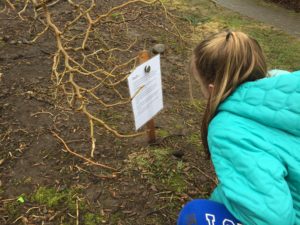You’d miss that a rose had been pruned if it weren’t for the sign. Since it has been pruned, it’s a great opportunity to do a little guerilla education.
This post isn’t about a particular gardening technique, per se, but about our relationship to the land and how as caretakers of it, we are in a position to assist others in seeing more and knowing more about it.
I suppose in a general manner of speaking, we go through life fairly blind. Our brain seems sophisticatedly adapted to pattern recognition, but once patterns are locked-in, they are internalized so that we can devote our energy to dealing with novelty and emergency. All this to say that much of what we see, we don’t really “see” because we have consigned it to the backdrop of our life’s drama, and the noisy, new actors are always getting our conscious attention.
I recognized this a short time ago at the school where I teach gardening. During a pruning session, I realized much of the work would be lost on passers-by, who wouldn’t perceive enough novelty or change to see that something had happened. Even if they did notice something, that wouldn’t ensure they would be able to make sense of what they noticed. Thus was born in my mind the idea of a temporary, pop-up sign, which emerges after some work has been done or when some phenomenon (say, a hatch of insects) is occurring, stays just long enough to remain relevant and fresh and keep people’s attention, then disappears with its educational mission accomplished.
Here I wanted to make sure that people knew two shrubs were not being wantonly removed but that new growth was the reason for the radical sawing.
We’ve all seen interpretive signs at nature centers, and these can be useful at teasing out the meaning or a lesson from an otherwise jumbled and inscrutable landscape, but for the frequent visitor, their static nature all but insures that they will become just another layer that our brains will patternize and deemphasize. Temporary, pop-up signs remain fresh because they’re not there long enough to habituate to them.
At school we have the benefit of a laminator, which I always joke is a teacher’s attempt at being eternal (as we won’t have enough money to put our name on a building!). With that laminator, a wooden stake and whatever prose I can muster on a piece of paper, I can make weather-proof signs that are well suited to this guerilla-learning strategy. I think the method has tremendous potential for gardeners and landscape caretakers, but also for associated types like geographers and urban planners. And, as we all know, activists already have a corner on the market. Who can resist reading a banner freshly-draped from some interstate bridge? Their trespass almost effectively guarantees their success because their work is sure to be ephemeral and thus noticed.



